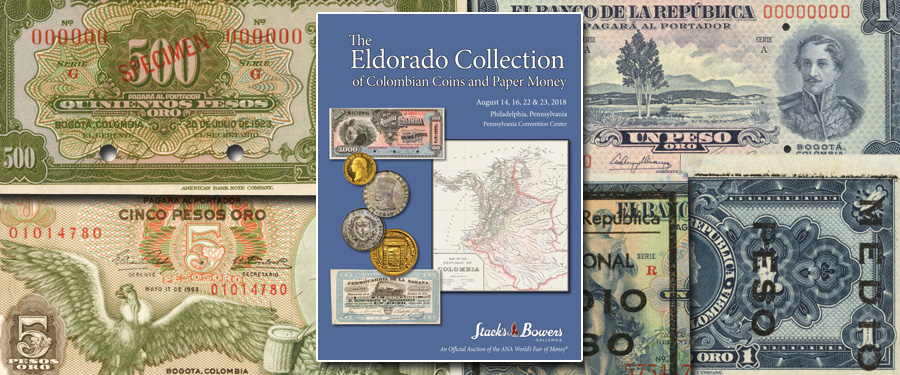
The
second portion of the Eldorado Collection of Colombian Paper Money, offered in
the Stack’s Bowers Galleries auction at the 2018 ANA Worlds Fair of Money,
continues with exceptional examples never before cataloged in an American sale
or anywhere else. Combined with the initial January 2018 Part I auction, these
catalogs portray the broadest view of the subject ever published in English or
Spanish. Commencing in 1819 and continuing to the present day are countless
note types and varieties, from the majority of known series and issuers. The
reception for the first auction sale was exceptional. This is often the case
when great rarities are acquired for decades and presented in this fashion,
reflecting the passion collectors have for these items.
Our
Part II Eldorado Paper Money sale differs greatly from the Part I catalog and
contains many note types and series not featured in the first sale, or there as
Proofs only. However, like the first auction, there are several earlier notes,
rare private Bancos, and Proofs that were originally discovered in the American
Banknote Company archives and sold by Christie’s. In addition, this sale
contains the finest offering of modern 1923-1980 República de Colombia notes
ever. Decades ago, many of these could be picked out of original packs of new
notes. That is not the case now. There are multiple types from the 1930s to
1970s, that are in exceptional grade and perhaps the finest known. The current
published catalog values for these were printed years ago and have never been
changed. However, collecting enthusiasm for these modern notes and all
Colombian numismatics has increased greatly in the past several years. Session
J is a significant Internet Only offering, that includes many important
condition rarities, finest known, and eclectic types that are cataloged and
studied carefully for the first time.
Earlier
República notes include a strong offering of (Law of) 1923 notes which were
created with the help of American economist Edwin Kemmerer. These gold standard
(“Peso Oro”) notes are rare as they were either paid in gold or redeemed for
later issues. This historic series evolved into many other series printed by
the American Bank Note Company, Thomas de la Rue, and eventually in 1959, the
state banknote printing company. The amount of paper required due to inflation,
made it too costly to have world security printers work on a contract basis.
Many of these earlier dated types are surprisingly scarce or rare in high
grades. Because of the immense amount of notes being printed compared to the
1950s and before, the first replacement notes appeared with a special “r”
designation and serial number prefixes. Few were saved, likely because at the
time most collectors did not know their significance. Again, the selection of
Colombian replacement notes certified by PMG is the most comprehensive in
history and is likely to further their detailed study and census enumeration.
Significant
in this catalog is the most exhaustive study and offering of Departmental and
Gobierno notes resulting from the economic and political instability that
culminated in the “1000 Days War” from 1899 to 1902. The “1000 Days War”
created these and other locally printed, regional, and emergency issue paper
notes, much of which was crudely produced under difficult conditions. High
grade notes are the exception for these emergency notes due to the tropical
climate and rag paper used for them. Many notes are finest for their types or
the first seen in an American sale. Their historical importance is unquestioned
and they represent a genre of Colombian paper money that is very charming.
There are other local, railroad, and private issues in this sale that are also
extremely rare. Items related to engraving and financial history complete the
auction catalog entries.
The
study of Colombian paper money has been amplified by the Eldorado Collection
offerings and the opportunities presented. From the second known 1895 1000
Pesos P-241s Specimen note to a collection of modern issue Peso notes, all were
curated with devoted attention for decades. Often they represent the only known
example, the finest grades of their types, or a nuance worthy of further of
study. Stack’s Bowers Galleries has been privileged to present this
foundational collection in its entirety.





